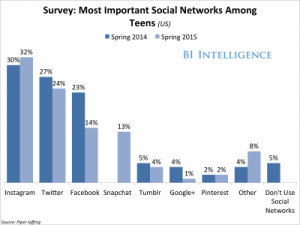INSTAGRAM ADS PERFORMING WELL
While the minimum spend to work with Instagram directly is still too pricey for book publishers, those larger brands currently working with the platform are reporting highly efficient campaigns.
“For now, Instagram is still a premium ad space, according to marketing experts. Salesforce says Instagram ads get almost double the click through rate of Facebook, 1.5 percent compared to 0.84 percent.”
The good news is that we can access Instagram through beta programs with such partners as AdRoll.
#social #instagram #retargeting
INDUSTRY VARIATIONS IN MOBILE V. DESKTOP
While the pace of change is definitely tilted in the direction of mobile, different industries still see a majority of email opens on desktop devices:
“In the business products and services industry, for example, 73% of emails were still opened on the desktop—and the tablet open share was just half the average. Publishers, media and entertainment companies and travel firms all had slightly higher-than-average open shares on the desktop, while publishers and travel firms reported clearly lower-than-average open shares on mobile phones.”
“FACEBOOK BEATS PINTEREST AS FOODIE’S GO-TO SOCIAL PLATFORM”:
“Foodies in the U.S. are particularly active on social media, especially on Instagram. Here’s a few of the U.S. stats that should be intriguing to food marketers:
-
90 percent of American foodies use Facebook.
-
36 percent of them visit Pinterest.
-
73 percent scroll through Instagram (a big leap from 17 percent worldwide).”
On the other hand:
“Benjamin Bourinat, director of public relations and social media at Sopexa, explained that while Pinterest claims a low percentage of users, people come back repeatedly to the site and app. ‘What’s interesting about Pinterest is [that it’s] very niche—the level of engagement is high because loyalty is just stronger on Pinterest,’ he said.”
WECHAT OPENS AD PLATFORM ANOTHER NOTCH WIDER
WeChat recently opened their “Sponsored Moments” platform to wider advertising. As the minimum spend drops from roughly $800,000 to about $31,000, the platform is now within the range of a large book advertising budget. The service does not have the U.S. presence that would make it useful to American publishers, but it’s a good development for the future of messaging as an advertising medium
FACEBOOK AD PERFORMANCE UPDATE
New Facebook stats were recently announced, including average CTR, CPM, and CPC across the platform for Q2 2013 and 2014. Spoiler alert, everything’s going up: .36% CTR, $1.95 CPM, and $0.55 CPC for Q2 2014.
REACHING GAMERS ON YOUTUBE
YouTube NOW aggregates 25,000 gamer channels. It’s a huge market, especially good for reaching young males. But it’s not only about young males, which Kimberly-Clark makes clear, targeting women with a :30 spot for Kotex.
NEW FACEBOOK AD UNITS
Animated .gifs come to Facebook . . . for Wendy’s and Coke, anyway. The good news is that this kind of test heralds the opening of the platform to gifs from other advertisers relatively soon.
NEW MOBILE MESSAGING AND SOCIAL MEDIA STATS
Pew has released a new survey of mobile messaging and social media. Some key figures:
- 36% of mobile users use messaging apps such as WeChat or Kik (49% of ages 18-29)
- 17% of mobile users use messaging apps in which messages instantly disappear (as in Snapchat) — 41% of ages 18-29
- 59% of Instagram users visit the site daily (70% Facebook, 27% for Pinterest and 22% for LinkedIn)
- 62% of all American adults use Facebook (66% of male internet users, 77% of female internet users)
NYT DIGITAL SUBSCRIBERS UP
The New York Times reaches 1MM digital subscribers.
NYT NEWSLETTER NEWS
New York Times gets 20% open rate in newsletters. How? Highly curated by trusted editors plus a seriously engaged opt-in audience. It’s why we love them.
GOOGLE’S BEST PRACTICES FOR BANNER CREATIVE
Google released a pretty good primer on banner ad creative.
SLOW JOURNALISM IS IN OUR WHEELHOUSE
Nieman reports on the value of slow journalism (that’s our specialty, book people) in the age of instant information.
#news
PROGRAMMATIC VIDEO DEVELOPMENTS
Hulu is experimenting with opening their video ad platform to programmatic buying.
IS INSTAGRAM CHANGING HOW AGENCIES APPROACH CREATIVE?
Spoiler alert: Yes, creative is getting much less spontaneous in look and feel. Our favorite quote comes from Chris Corley, group creative director at VML in Kansas City:
“I think we do have the obligation to sell, but we also have an obligation to not pollute the world with garbage.”
Fair enough.











